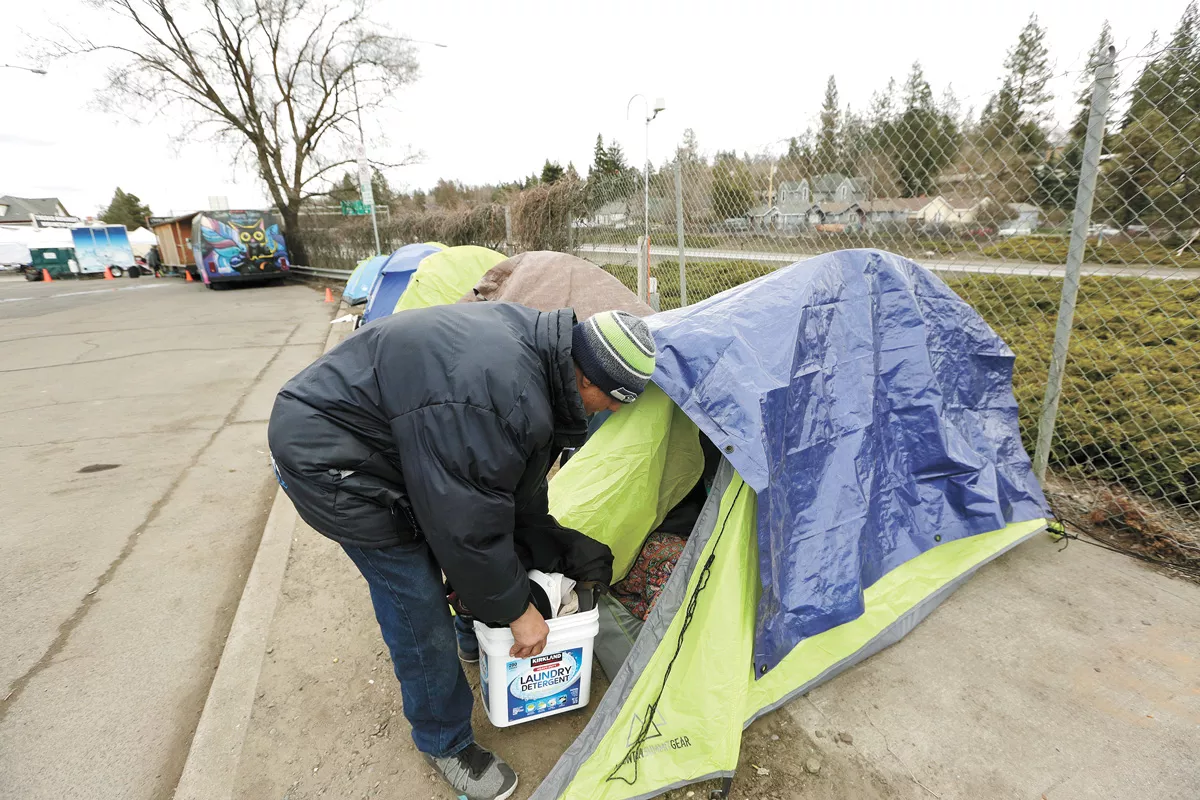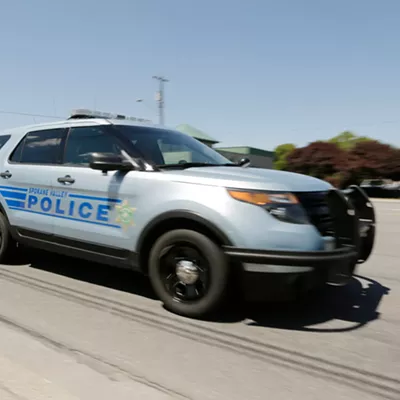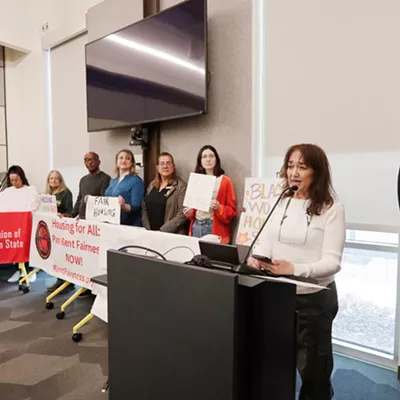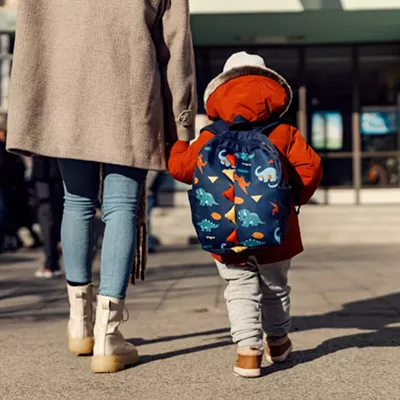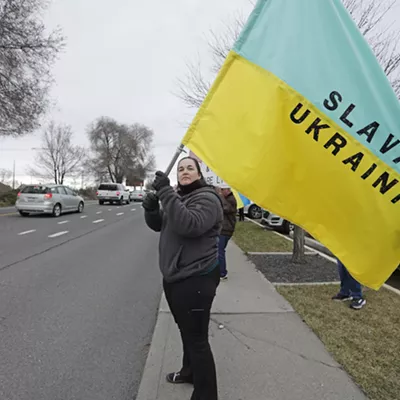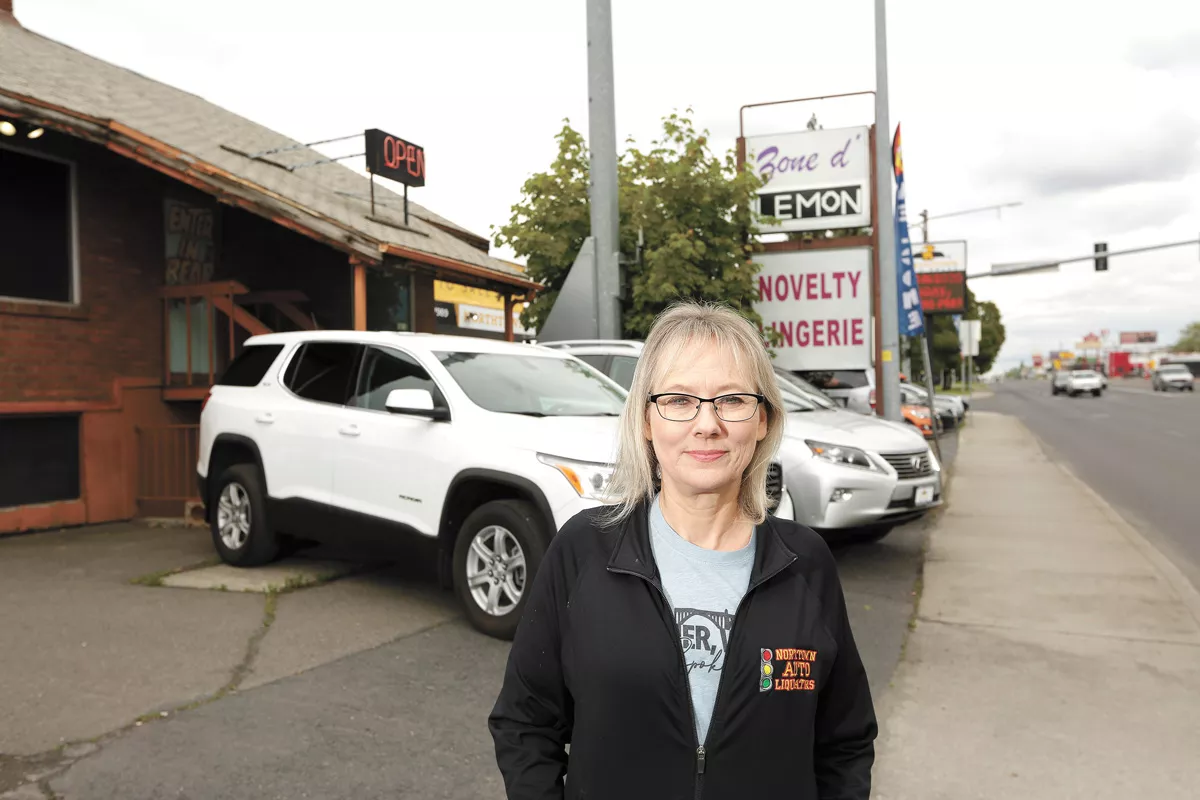
LOCKDOWNS PITTED "ESSENTIAL" BUSINESSES AGAINST EVERYONE ELSE
Previous years introduced new slang like "manspreading" and "metrosexual" into the cultural lexicon. In 2020? We got phrases like "social distancing" and "essential businesses," bland jargon that our lives and our livelihoods depended on.
By March 23, Washington Gov. Jay Inslee had officially issued his "Stay Home, Stay Healthy" order, shuttering most businesses in an attempt to slow the spread of the coronavirus before it completely overwhelmed our health care system.
Yet not all businesses were shut down. Grocery stores, of course, were allowed to continue to operate. Everyone could agree on that. But then there were other industries labeled "essential businesses" — like cannabis shops and liquor stores — that were far more controversial.
Then there were those like local Spokane sex shops that claimed to be essential under dubious interpretations of Inslee's rulings. Others quietly defied the order.
After Washington state launched an online reporting system allowing the public to accuse businesses of violating the stay-home order, tens of thousands of accusations flooded in. Some complaints came from employees, terrified of being asked to work as the pandemic spread. Yet other complaints were from business owners, incensed at watching their competitors get away with breaking the rules while they suffered by following them.
"I was told by the state that residential house cleaning is nonessential," a local cleaning business owner wrote in one of the complaints obtained through public records. "Now I'm doing the right thing and competitors are stealing our clients. Not playing fair."
Meanwhile, when Idaho Health and Welfare put up an online reporting form to report scofflaw businesses violating lockdown orders, it was met with so much backlash that the agency quickly removed it.
As the lockdowns began to be loosened when warmer weather approached, the controversy around who was "essential" began to dissipate.
For all the economic pain that had resulted, the lockdowns seemed to have worked, at least for a time: The infection rate fell, hospitals survived, and we bought time for vaccine research. But when the fall hit, a bigger-than-ever viral wave ushered in a new round of lockdown and restrictions.
The good news is we will soon have a trio of new vaccines in our arsenal. But they come with a new ethical dilemma to fight about: With a limited supply of shots, who counts as "essential" enough to get immunized? (DANIEL WALTERS)
CONSPIRACY THEORIES BECAME AN EPIDEMIC
Conspiracy theorists have always been a thriving part of the American culture, offering their outlandish perspective on everything from JFK to the moon landing and 9/11.
And considering that the current president of the United States built his political brand by promoting a particularly noxious conspiracy theory — the lie that Barack Obama wasn't born in the United States — it was, perhaps, inevitable that the Trump era would be defined by bizarre, and even dangerous, conspiracy theories. Indeed, out of the pits of racist troll sites like 4chan emerged the QAnon conspiracy theory that Trump was secretly battling a vast network of cannibalistic, child-sacrificing elite liberal pedophiles.
Then came COVID-19: The science around the coronavirus was so new and tenuous — with expert opinion shifting around questions like masks and airborne spread — that the conspiracy theories grew like weeds between the cracks.
In Idaho, anti-government and anti-vaccine forces merged into the "People's Rights" movement, led by Malheur National Wildlife Refuge occupation leader Ammon Bundy. They broke a glass door while storming the halls of the Idaho Capitol. They crowded around the Boise mayor's home with tiki torches screaming about lockdowns.
Even as Facebook began cracking down on pages like QAnon, their site still brimmed with falsehoods about China bioengineering the coronavirus, about sex traffickers using masks to hide duct tape on their victim's mouths, and about left-wing radical "antifa" members setting wildfires.
It all culminated with the grand finale: a conspiracy theory about a stolen election. Trump spent the last two months of the year denying, despite all evidence, that he had lost the election.
"Very big illegal ballot drop that cannot be accounted for," Trump tweeted on Dec. 21. "Rigged Election!
(Just below his tweet, Twitter issued a rote disclaimer: "This claim about election fraud is disputed.")
Instead, Trump's allies spun out an increasingly outlandish series of false claims — that scores of dead people had voted, that voting machines had been manipulated by Venezuela — only for them to be repeatedly laughed out of court.
Still, even U.S. Rep. Cathy McMorris Rodgers — a politician squarely in the middle of the Republican Party — signed her name to support a lawsuit asking the Supreme Court to overturn the election.
"This case is about the Supreme Court answering those questions for the American people so we can move forward," McMorris Rodgers said in a press release.
The Supreme Court, including all three of the justices Trump had nominated, refused to even consider such a lawsuit.
But conspiracy theories, as 2020 has shown, have real-world consequences.
Just as armed vigilantes terrorized a Spokane family in Forks, Washington, because they thought their bus was filled with "antifa" terrorists, this month a former Houston police captain ran a truck off the road and held the driver at gunpoint because the assailant thought the truck was filled with illegal ballots.
Next year, public health officials will try to convince the public to save lives by taking a rigorously tested vaccine. But they'll be competing against thousands of conspiracy theorists who claim the vaccine is a ploy for Bill Gates to inject you with microchips. (DW)

TRUMP LOST AND MATT SHEA LEFT — BUT THEIR LEGACIES LIVE ON
OK, so there wasn't exactly a blue wave.
Whether because of a summer of civil unrest, the socialist far-left, weak centrist candidates or just poor Democratic leadership, this November was not the rout Democrats were counting on. The Democratic Party lost ground in the U.S. House and has to rely on a special election in Georgia for a shot at controlling the Senate.
Still, Joe Biden managed to defeat Donald J. Trump to take back control of the White House.
Local Democrats could also take comfort in the fact that Washington state Rep. Matt Shea — the Spokane region's most controversial local celebrity since Rachel Dolezal — decided not to run for re-election.
After an independent investigation last year accused him of planning and participating in acts of "domestic terrorism," the Spokane Valley rep had been booted from the Republican caucus.
With Shea not running again, it gave Republicans like Washington state House Minority Leader J.T. Wilcox an opportunity to turn the extremism charge against Democrats, pointing to rioting in Seattle to argue that Democrats "have been scared to death to touch" the topic of "not just the threat of political violence but actual political violence from people on the left."
Yet the spirit of Matt Shea lives on.
It lives on in Rob Chase, the candidate who ran in Shea's district and with his endorsement. Chase shares Shea's penchant for conspiracy theories, dabbling in conspiratorial thinking about everything from QAnon to 9/11 and COVID-19. Running in the deeply conservative Spokane Valley, Chase walked away with 62 percent of the vote.
The spirit of Shea also lives on in Rep. Jenny Graham, a Spokane-area state rep who responded to an Inlander story about her unwittingly sharing links to conspiracy-theory sites by calling the reporter a "c—-sucker" and a "lying piece of shit," falsely claiming she'd been misquoted and threatening legal action. Graham's profane voicemail received national attention, yet she went on to win her race by more than 8 points.
And the spirit of Shea lives on in Rep. Robert Sutherland, a Snohomish-area Republican who recently called on his followers to "prepare for war," claiming in Facebook comments that while America was "being destroyed by evildoers," "good and decent people" would go to war to defend life and liberty.
The spirit of Trump lives on too, naturally. Even though Republican Loren Culp suffered the biggest defeat for a Washington state Republican gubernatorial candidate in 20 years, he refused to admit he lost. Instead, Culp cried voter fraud, sued Washington state's Republican secretary of state and claimed that the election itself was illegal.
It puts Republican leaders across the nation in a bind: How does the Republican Party move on from candidates like Trump and Culp, when they won't even admit they lost? (DW)
IN THE MIDDLE OF A PANDEMIC, SPOKANE'S HEALTH OFFICER IS FIRED
Startling many in the community in late October, Spokane Regional Health District administrator Amelia Clark moved to fire Dr. Bob Lutz, the district's health officer, after the two butted heads. Clark insisted Lutz was insubordinate, including when he co-signed an op-ed saying not to return to in-person school too soon, and when he emailed local lawmakers a study about reducing child death risks from guns. Lutz insisted his public communications were part of his role as health officer and noted that he'd asked for mediation between him and Clark this summer when multiple issues between them came to light, but it was not provided.
In fact, on Oct. 29, Clark didn't put Lutz on a disciplinary plan with human resources, as members of the board of health had expected. Instead, when Lutz refused to apologize, Clark says she decided to immediately fire him, demanding his resignation and signature on a nondisclosure form if he wanted to receive severance pay. She also took his keys and barred him from his office.
But only the health board can actually fire the health officer or administrator. So by Nov. 5, the health board held a special meeting to allow both parties to air their grievances before a majority decided to fire Lutz.
Questions still remain over the firing, which many have pointed to as potentially politically motivated. Many wondered if disagreements over shutdown measures played a role in the decision, as health officers around the country have faced criticism and even threats for their roles during the pandemic.
Spokane County Commissioner Al French, who sits on the health board, strongly pushed to oust Lutz and replace him with Dr. Francisco Velazquez, whom French nominated to fill the interim role. French was an early advocate of reopening the county as fast as possible.
Clark's actions — i.e., firing Lutz without the authority to do so — are now under investigation by the state Board of Health. (SAMANTHA WOHLFEIL)
EPIC WILDFIRES RAGED ACROSS THE NORTHWEST
It almost seemed like Washington might escape another devastating wildfire season, with few large fires sparked throughout the summer.
But then came Labor Day, and the landscape throughout the Pacific Northwest lit up like a tinderbox. More than 5 million acres burned across Oregon, California and Washington in the weeks following. In just 72 hours, Washington saw more than 600,000 acres burn, more than half the previous record for an entire year, set in 2015.
In Oregon, towns were devastated and nearly a dozen died as their escape routes were blocked by flames and downed trees. In central Washington, a couple trying to outrun the massive Cold Springs fire on foot were badly burned and their baby boy was killed.
The tiny Whitman County communities of Malden and Pine City were nearly wiped off the map, with nearly every home and city destroyed by flames in just hours.
Yet fire and forestry experts say we know what needs to be done to prevent this in the future. Aside from taking climate change and hotter, drier seasons into account, the area around homes and towns can be landscaped with native and water-heavy plants to discourage fire from getting too close; some also prescribed burning and thinning of forests to help.
Most of all, while fire suppression is absolutely needed, in some cases, it may help to simply let more of the forest burn, as fire has been a natural part of Northwestern forest ecology for ages.
"I don't think there's a future without fire and smoke, and as a matter of fact I think we'll have more of this," says John Bailey, professor of forest engineering, resources and management at Oregon State University. "For me, it's clear the choice is to manage our fuels. ... Because the areas that burned this year will burn again." (SW)
THE LARGEST PROTEST MOVEMENT IN U.S. HISTORY GAINS STRENGTH
Last spring, the nation took to the streets to mourn and protest the police death of George Floyd, a Black man who was killed on May 25 after white Minneapolis Police Officer Derek Chauvin knelt on his neck for 8 minutes and 46 seconds. Floyd was being arrested on suspicion of using counterfeit money at a convenience store.
As they have following other outrageous deaths, protests erupted around the country calling for massive overhauls to criminal justice and policing systems that disproportionately kill and target people of color.
By May 31, the first protest was set for Spokane. Hundreds gathered in Spokane's Riverfront Park, as speakers shared local stories of racial profiling. Officers who'd been standing in normal uniforms across the street quickly put on riot gear after one man started acting erratically, but things remained peaceful for hours.
Even as protesters marched to the Spokane County Courthouse and got right in the faces of officers in full helmets and riot gear, no physical clash happened between officers and protesters that afternoon.
However, shortly after things appeared to fizzle out at the courthouse, a small group of people went downtown, where some broke into the Nike store and began looting. From that point on, Spokane police determined that anyone remaining downtown would be treated as a rioter. Whether they be teenagers raising their hands and shouting "hands up, don't shoot" or young adults sitting crisscross in the street, those attempting to continue to protest faced hours of tear gas, flash bangs, foam bullets and rubber dispersal rounds meant to be fired at the street to scare people off. A city curfew was implemented, and a dozen arrests were made.
Over the following week, protesters gathered nightly at the Red Wagon, before another peaceful protest took place in the park the next weekend. Again, things were peaceful, and this time, rather than confront the crowd in riot gear, police hung back and opted not to engage. However, a helicopter did swoop the crowd when a small group eventually made its way to the courthouse, where a line of heavily equipped National Guard members and Washington state troopers stood behind barricades.
No tear gas or other less lethal crowd control was used that night, but the community conversation continued as people demanded justice not just for Floyd but for local people of color who've disproportionately faced uses of force from regional law enforcement. (SW)
SCHOOLS FACED AN IMPOSSIBLE CHOICE: TO CLOSE OR REOPEN?
By Friday, March 13, with the virus spreading and dozens dead from COVID-19, Gov. Jay Inslee was trying to do what he could to "get ahead of this wave" that was coming. So he made an announcement: For at least six weeks, schools would close.
The school closure would end up lasting much longer than those six weeks — both in Washington and in schools across the country. And it proved to be perhaps the single biggest disruption to daily life for young people and their families during the pandemic.
The school shutdown lasted through the end of the school year, and during that time teachers struggled to teach students remotely. They weren't always successful. Some students didn't have an internet connection and couldn't be reached at all. Others were more worried about their next meal than trying to navigate virtual learning.
Come summertime, schools faced an impossible choice: Open in the midst of a pandemic, and risk putting students, teachers and families at further risk. Or keep doing distance learning, knowing many students will fall further behind.
Under the recommendation of the Spokane Regional Health District, Spokane Public Schools started schools remotely. Others flouted the recommendation, like Mead, and began with a hybrid model. In Coeur d'Alene, schools went to full-time in-person instruction.
For the schools that opened for in-person instruction, it was a bit of an experiment as to how the virus could spread in schools. The schools that did hold in-person classes had students and teachers test positive, to be sure. But in most cases locally, the virus wasn't spreading inside school buildings. A major obstacle, however, was that close contacts of positive cases had to quarantine — in Coeur d'Alene, that resulted in hundreds of students in a school having to go back home, though many weren't sick.
Yet as the data piled up, health experts began to believe that school classrooms could be relatively safe, as long as proper precautions were in place. This was true for universities, too. Whitworth and Gonzaga, for example, both opened in-person classes and didn't have any major outbreaks. Yet Washington State University had a major outbreak in Pullman despite most classes being held online. That was because students moved back to Pullman anyway, and held social gatherings where the virus spread.
Ultimately, the community spread remains a problem today. Gov. Inslee has recommended that K-5 students return to in-person school, but districts like Spokane Public Schools remain cautious. That's partly because with a surge in cases locally, more students will be in classes with the potential to spread COVID.
As a new year arrives, and a vaccine is slowly rolled out, schools should start opening up slowly as well. But by that point, some students may have been held away from school buildings for nearly a year. (WILSON CRISCIONE)
THE REGION GRAPPLED WITH SHELTERING THE HOMELESS
The year began with Nadine Woodward, the former local TV anchor, starting her first term as Spokane's mayor following a campaign that focused on a tougher approach to homelessness.
Quickly, the pandemic brought with it new challenges on addressing homelessness in Spokane. With so many people crammed into a tight space, homeless shelters theoretically presented COVID-19 with a perfect place for a superspreader event. And that fear set into motion a series of events that upended the way Spokane's shelter system would look.
The city was already short on bed spaces for people experiencing homelessness. And because of COVID-19, local shelters cut their capacity in an effort to maintain social distancing, which further reduced bed spaces.
To make up the difference, Spokane turned the downtown public library into a temporary shelter. A shelter on Cannon Street — operated then by Jewels Helping Hands — provided additional space for unhoused individuals. When that contract ended, the Spokane Arena served as a temporary shelter over the summer. Then, Spokane County devoted federal aid to help open a shelter at 55 W. Mission, operated by Salvation Army.
There was optimism among local leaders that going into the winter, the city wouldn't be scrambling for more bed spaces like in years past. Indeed, the shelter system has grown since prior years, but those working with unhoused people worry that it's still not meeting the need.
And meeting that need remains crucial to the city's effort to direct homeless people to services. Shelter space is necessary for enforcing laws against public camping or sitting and lying on downtown sidewalks, according to a federal court ruling, but an Inlander investigation this fall found that Spokane police sometimes still cite people for those violations even when there's no shelter space available.
Finally, this year ended with yet another controversy surrounding shelter space. Spokane received a grant for a new young adult shelter that came with a deadline to find one by the end of the year. But Woodward didn't want the shelter inside city limits, causing discussions over where to put it to stall. City and regional leaders eventually landed on a plan to temporarily add those bed spaces to existing shelters while a permanent location is found. Woodward softened on her stance against the shelter being in Spokane when it was agreed that the shelter operator — not the city — would do neighborhood outreach wherever the shelter goes, says City Council President Breean Beggs.
"[Woodward] feels like people blame her for having a shelter near them," Beggs says. "She says she doesn't have the bandwidth to deal with general unhappiness about shelters." (WC)
THE CARES ACT STAVED OFF THE WORST — FOR A WHILE
With millions of people out of work and the economy reeling from the pandemic, the federal government made an attempt to provide some relief this spring.
The $2.2 trillion Coronavirus Aid, Relief and Economic Security (CARES) Act gave people $1,200 checks, and it gave people who lost their jobs added unemployment benefits. It also established a Paycheck Protection Program to assist businesses in paying employees.
But it didn't always go smoothly. Unemployment agencies were overloaded, leading to long delays for some people to receive unemployment benefits. It didn't help that fraudsters took advantage of a software vulnerability to steal $600 million from the Washington Employment Security Department.
Meanwhile, the relief may not be enough to prevent people from losing their homes. Housing advocates fear that a tsunami of evictions will occur once the state eviction moratorium ends. Locally, they're asking Spokane County commissioners to use some of the CARES dollars they received for rental assistance.
The county, as of this writing, still has CARES money to be spent, but the deadline to spend it was extended in the new stimulus bill to the end of 2021. (WC) ♦



